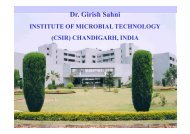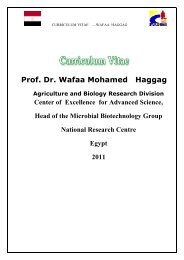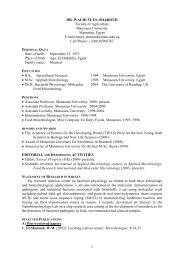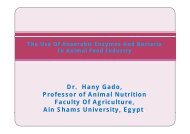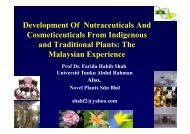Presentation
Presentation
Presentation
Create successful ePaper yourself
Turn your PDF publications into a flip-book with our unique Google optimized e-Paper software.
ENGINEERING OF DAIRY PROTEINS AND THE MODULATION OF<br />
THEIR STRUCTURES -<br />
MICELLISATION AND IMMUNO REACTIVITIES OF<br />
DIMERIC DIMERIC BETA BETA CASEINS CASEINS.<br />
Thomas Haertlé<br />
Institut National de la Recherche Agronomique, Nantes, France<br />
The France-Egypt Year Of Science And Technology, 2010
Importance of milk<br />
Essential food of newborn (nutrition, immune protection,<br />
enzymes).<br />
Cow, goat and sheep in Western countries.<br />
Mare, water buffalo, camel, yak…in y Eastern countries.<br />
Consumed without or after transformation (cheeses, fermented<br />
milks).<br />
Of great importance for food industries of each human society.<br />
The France-Egypt Year Of Science And Technology, 2010
Average composition<br />
of f cow milk ilk<br />
Synthetisised by secretory epithelial cells (synthesis of<br />
components or their capture from blood)<br />
12 12-13 13 % of fd dry matter tt (120-130 (120 130 g/L) /L)<br />
PProteins i (32-35 g/L) LLactose (47-52 g/L) FFats<br />
(33-45 g/L)<br />
Caseins (26-28 ( g/L) g )<br />
Precipitation at pH 4,6<br />
The France-Egypt Year Of Science And Technology, 2010<br />
Salt min.<br />
(7 g/L)<br />
BLG<br />
(2 (2-44 g/L) /L)<br />
Wh Whey<br />
ALA<br />
(1-1,5 g/L) LF<br />
Ig BSA
Bovine caseins<br />
Casein αS1 αS2 β κ<br />
AA<br />
199<br />
207<br />
209<br />
169<br />
MM (kDa) 23,6 25,25<br />
24<br />
19<br />
Variants 5<br />
3<br />
6<br />
6<br />
Cys<br />
0<br />
2<br />
0<br />
2<br />
S-S Bridges 0<br />
0<br />
0<br />
0<br />
Ser-P Ser P<br />
8<br />
11<br />
5<br />
2<br />
Glycosylation No<br />
No<br />
No<br />
Yes<br />
Major ep. 6<br />
4<br />
6<br />
8<br />
Minor ep. 3 66<br />
3 0<br />
UUnknown k th three-dimensional di i l structures t t<br />
Unknown functions (nutritional, only ?)<br />
Quite often allergenic.<br />
The France-Egypt Year Of Science And Technology, 2010
Caséine κ<br />
169 aa<br />
19037 Da<br />
1<br />
Chymosine<br />
Glycosylation<br />
Cys y Cys y<br />
P of caseins<br />
11 Para-Kappa 88 105/106 CMP 149<br />
Hydrophobe<br />
Hydrophile/chargé -<br />
Caséine β<br />
209 aa<br />
23983 Da<br />
Amphiphile<br />
Plasmine Plasmine<br />
P PPP<br />
P<br />
1 15 17-19 35<br />
105/106<br />
209<br />
28/29 107/108<br />
Hydrophile/chargé -<br />
Caséine αs2 207 aa<br />
25226 Da<br />
Amphiphile<br />
PPP P P CysCys PPP<br />
P<br />
P P P<br />
Tè Très peu chargé h é<br />
Hydrophobe<br />
1 8-10 16 31 56 56-58 5 61<br />
129 131 143<br />
207<br />
36 40<br />
Hydrophile/chargé -<br />
Caséine αs1 199 aa<br />
23615 Da<br />
Hydrophobe<br />
Dipôle<br />
PP PPP P P P<br />
1 46 48 64-68<br />
75 115<br />
199<br />
Hydrophobe Hydrophile/chargé - Hydrophobe Hydrophobe<br />
169<br />
The France-Egypt Year Of Science And Technology, 2010<br />
Physico-chemical properties<br />
of caseins<br />
Casein micellisation according to Holt<br />
(1998)
20 - 300 nm<br />
(Schmidt, Schmidt, 1982 ; Walstra, 1984)<br />
1984<br />
Casein micelle<br />
The France-Egypt Year Of Science And Technology, 2010<br />
glucids<br />
submicelle<br />
α αs11 αs β 2<br />
κ<br />
CCP Colloidal Calcium<br />
Phosphate
P<br />
P P P<br />
β casein<br />
MKVLILACLV ALALARELEE LNVPGEIVES LSSSEESITR INKKIEKFQS<br />
EEQQQTEDEL QDKIHPFAQT QSLVYPFPGP IPNSLPQNIP PLTQTPVVVP<br />
PFLQPEVMGV Q SKVKEAMAPK HKEMPFPKYP VEPFTESQSL Q TLTDVENLHL<br />
PLPLLQSWMH QPHQPLPPTV MFPPQSVLSL SQSKVLPVPQ KAVPYPQRDM<br />
PIQAFLLYQE PVLGPVRGPF PIIV<br />
Phosphorylation calcium fixation (binding of other caseins by<br />
phosphocalcic bridges)<br />
Hydrophilic NN-terminus terminus (several negative charges)<br />
Long hydrophobe C-terminal sequence<br />
AMPHIPHILIC PROTEIN<br />
structures polyproline II<br />
Numerous Numerous prolines (35) scarce classic secondary structures (β sheets, sheets α helices …)<br />
)<br />
The France-Egypt Year Of Science And Technology, 2010<br />
P
Self-association of β casein<br />
Micellar aggregates<br />
Temperature and<br />
concentration ddependent d<br />
The France-Egypt Year Of Science And Technology, 2010<br />
Andrews et al. , 1979<br />
Payens et al., 1963<br />
Farrell et al., 2001<br />
Thurn et al. , 1987<br />
Kajiwara et al. , 1988<br />
Sood et al. , 1990<br />
Sood et al. , 1997<br />
Leclerc et al. , 1998<br />
Leclerc et al. , 1997
F I<br />
Trp 143<br />
monomer<br />
λ<br />
↑ °CC<br />
Intrinsic Fluorescence of<br />
tryptophan tryptophan (1) (1)<br />
F I<br />
micelle<br />
λ max Trp = 341 nm λ max Trp = 336 nm<br />
The France-Egypt Year Of Science And Technology, 2010<br />
λ
Enginering of β casein<br />
Recombinant β casein, wild type, expressed in E. coli : WT<br />
Recombinant β casein, mutated, expressed in E. coli: MU<br />
MRELEEL RELEELNVPG EIVESLSSSE ESITRINKKI EKFQSEEQQQ<br />
TEDELQDKIH PFAQTQSLVY PFPGPIPNSL PQNIPPLTQT PVVVPPFLQP<br />
EVMGVSKVKE AMAPKHKEMP FPKYPVEPFT ESQSLTLTDV ENLHLPLPLL<br />
QSWMHQPHQP LPPTVMFPPQ SVLSLSQSKV LPVPQKAVPY PQRDMPIQAF<br />
LLYQEPVLGP VRGPFPIIV<br />
Sequence containing three glutamates well conserved in Ruminants<br />
Addition of three negative charges: change of hydrophilic/hydrophobic ratio<br />
The France-Egypt Year Of Science And Technology, 2010
Same conditions as<br />
for DLS.<br />
λmmax<br />
Trp<br />
1 mg/mL<br />
00,4 4 mg/mL<br />
λmaxTrp<br />
0,2mg/mL<br />
λmaxTrp max Trp<br />
λm<br />
342<br />
340<br />
338<br />
336<br />
334<br />
332<br />
342<br />
340<br />
338<br />
336<br />
334<br />
332<br />
Native<br />
Intrinsic Fluorescence of<br />
Tryptophan Tryptophan (1) (1)<br />
(2)<br />
10 20 30 40 50<br />
Temperature, °C<br />
WT<br />
10 20 30 40 50<br />
T emperature, t °C<br />
Temperature, °C<br />
λmmaxTrp<br />
max Trp<br />
λm<br />
The France-Egypt Year Of Science And Technology, 2010<br />
342<br />
340<br />
338<br />
336<br />
334<br />
332<br />
MU<br />
10 20 30 40 50<br />
Temperature, °C
Beta casein native<br />
+ 3 HNeRELEELNVPGEIVESLSSSEESITRINKKIEKFQSEEQQQTEDELQDKIHPFAQTQSLVYPFPGPIPNS<br />
3<br />
LPQNIPPLTQTPVVVPPFLQPEVMGVSKVKEAMAPKHKEMPFPKYPVEPFTESQSLTLTDVENLHLPLPLLQ<br />
SWMHQPHQPLPPTVMFPPQSVLSLSQSKVLPVPQKAVPYPQRDMPIQAFLLYQEPVLGPVRGPFPIIV<br />
COO -<br />
Beta casein simple mutant C4<br />
+ 3 HNeMGRELECLNVPGEIVESLSSSEESITRINKKIEKFQSEEQQQTEDELQDKIHPFAQTQSLVYPFPGPIPNSLPQNIPPLTQTP<br />
VVVPPFLQPEVMGVSKVKEAMAPKHKEMPFPKYPVEPFTESQSLTLTDVENLHLPLPLLQSWMHQPHQPLPPTVMFPPQSVLSL<br />
SQSKVLPVPQKAVPYPQRDMPIQAFLLYQEPVLGPVRGPFPIIV COO -<br />
Q Q Q Q Q<br />
Beta casein simple mutant C208<br />
+ 3 HNeMGRELEKLNVPGEIVESLSSSEESITRINKKIEKFQSEEQQQTEDELQDKIHPFAQTQSLVYPFPGPIPNSLPQNIPPLTQTPV<br />
VVPPFLQPEVMGVSKVKEAMAPKHKEMPFPKYPVEPFTESQSLTLTDVENLHLPLPLLQSWMHQPHQPLPPTVMFPPQSVLSLS<br />
QSKVLPVPQKAVPYPQRDMPIQAFLLYQEPVLGPVRGPFPICV COO -<br />
Beta casein double mutant C4 - 208<br />
+ 3 HNeMGRELECLNVPGEIVESLSSSEESITRINKKIEKFQSEEQQQTEDELQDKIHPFAQTQSLVYPFPGPIPNSLPQNIPPLTQTP<br />
VVVPPFLQPEVMGVSKVKEAMAPKHKEMPFPKYPVEPFTESQSLTLTDVENLHLPLPLLQSWMHQPHQPLPPTVMFPPQSVLSL<br />
SQSKVLPVPQKAVPYPQRDMPIQAFLLYQEPVLGPVRGPFPICV COO -<br />
The France-Egypt Year Of Science And Technology, 2010
SDS-PAGE of bovine β casein and mutants.<br />
Experimental condition: SDS‐PAGE (12.5 % gel), under reducing conditions.<br />
Coomasie blue staining.<br />
The France-Egypt Year Of Science And Technology, 2010
SDS-PAGE<br />
BCN C4-<br />
208<br />
Oxydation<br />
24 h at 25°C pH 6,5<br />
WT<br />
BCN C4 BCN C4-<br />
208<br />
BCN C4 WT<br />
kDa 0 1 10 24 M 0 1 10 24 0 1 10 24 M 0 1 10 24<br />
97,4<br />
97,4<br />
Trimer<br />
66,2<br />
Dimer<br />
Monomer<br />
«Intra» a<br />
66,2<br />
45<br />
31<br />
2 cys 1 cys<br />
The France-Egypt Year Of Science And Technology, 2010<br />
2-mercaptoethanol<br />
kDa<br />
45<br />
31<br />
21,5
SDS-PAGE of the dimerizing β casein mutants<br />
Condition: Tris buffer 50 mM mM, pH 88.2 2 including 80 mM NaCl and H2O2 H2O2, 37 °CC,<br />
stirred, sterile.<br />
The France-Egypt Year Of Science And Technology, 2010
• RReasons ffor quicker i k dimerization di i ti kinetics ki ti of f C208 ßß-CNs CN<br />
Greater mobility y of C-terminal segment g<br />
Easier access of SH function<br />
Hydrophobic interactions<br />
• The dimerization sites in C6- and C-208 ß-CNs<br />
• RELECSH(4)NVPGEIVESLSSSEESITRINKKIEKFQSEEQQQTEDEL<br />
QDKIHPFAQTQSLVYPFPGPIPNSLPQNIPPLTQTPVVVPPFLQPEVMGV<br />
• SKVKEAMAPKHKEMPFPKYPVEPFTESQSLTLTDVENLHLPLPLLQSWMH<br />
• QPHQPLPPTVMFPPQSVLSLSQSKVLPVPQKAVPYPQRDM PIQAFLLYQ<br />
• EPVLGPVRGPF PIIVCSH (208)<br />
The France-Egypt Year Of Science And Technology, 2010
Hydrophilic Hydrophilic-Hydrophilic Hydrophilic patterns of different β CNs<br />
Native β CN has distinct arrangement of hydrophilic (ψ) -hydrophobic(φ)<br />
fragments (ψ- φ).<br />
The dimeric β CNs are in some sense symmetrical<br />
C208 β CND (ψ - φ ~ φ - ψ)<br />
C4 β CND (φ - ψ ~ ψ - φ)<br />
The France-Egypt Year Of Science And Technology, 2010<br />
"P "Palindromic" lid i"
Casein β<br />
-C-C-<br />
-C-C- C C<br />
23983 Da<br />
Plasmin Plasmin<br />
P PPP<br />
P<br />
1 15 17 17-19 19 35<br />
105/106<br />
209<br />
28/29 107/108<br />
Hydrophilic/charged -<br />
Amphiphilic<br />
Little charged<br />
Hydrophobe<br />
The France-Egypt Year Of Science And Technology, 2010
Chhaperone-like<br />
activity ac (%)<br />
Chaperone-like activities of native and mutant monomeric<br />
ββ-CN. CN TTarget t protein t i - iinsulin li<br />
120<br />
100<br />
80<br />
60<br />
40<br />
20<br />
0<br />
0 0,025 0,05 0,075 0,1 0,125<br />
(ß-CN /Insulin) molar ratio<br />
Native β-CN (■), Wild type β-CN (□), C4 β-CN (▲) and C208 β-CN (∆)<br />
The France-Egypt Year Of Science And Technology, 2010<br />
Chemically-induced<br />
aggregation of insulin<br />
performed f di in the th présence é of f<br />
20 mM DTT at 40 °C.<br />
Mutant β-CNs exhibit<br />
considerably smaller<br />
chaperone chaperone-activities activities than that<br />
of native β-CN.
Importance of phosphoryl residues for chaperone<br />
acivities of ßß-CNs. CNs<br />
The hydrophilic segment of chaperones plays an essential role<br />
increasing solubilities of target proteins.<br />
The expressed in E. coli recombinant ß-CNs are not phosphorylated<br />
what decreases their amphiphilicity<br />
amphiphilicity.<br />
Amino acid Sequence of native ß-CN and the sites for phosphorylation<br />
Smaller polarity of hydrophilic domain is the reason for poorer<br />
chaperone p<br />
activities of the mutant ß-CNs.<br />
The France-Egypt Year Of Science And Technology, 2010
Consequence of Cys incorporation on chaperone-like<br />
chaperone like<br />
activities of ß-CN.<br />
Absence of cysteinyl residues, is one of the common features among<br />
different chaperone families.<br />
The C4 ß-CN and C208 ß-CN have cysteinyl residue in position 4 and 208,<br />
respectively.<br />
The ß-CNs containing cysteine showed almost similar chaperone-like<br />
activities ti iti as WT ßß-CN. CN<br />
Thus incorporation of cysteine has no significant consequence in<br />
chaperone chaperone-like like acti activity it of monomeric ßß-CN. CN<br />
The France-Egypt Year Of Science And Technology, 2010
Chape erone-like activity y (%)<br />
120<br />
100<br />
80<br />
60<br />
40<br />
20<br />
0<br />
Chaperone-like activities of the dimeric β-CN.<br />
TTarget t protein-ADH. t i ADH<br />
0 0,25 0,5 0,75 1 1,25 1,5 1,75<br />
(β−CN/ADH) molar ratio<br />
C208 ββ-CND CND (▲) (▲): HHydrophobic d h bi core, Pl Polar ends. d<br />
C4 β-CND (∆): Polar core, Hydrophobic ends.<br />
The France-Egypt Year Of Science And Technology, 2010<br />
Due to combination of flexibility and<br />
amphiphilicity, ß-CN acts as a surfactant<br />
molecule in solution.<br />
The dimeric β-CNs resembles<br />
somehow bis (gemini) - surfactants.<br />
C208 β-CND (ψ ‐ φ ~ φ ‐ ψ) has<br />
greater chaperone activity than C6 β-<br />
CND (ψ ‐ φ ~ φ ‐ ψ).<br />
C208 β-CND also shows greater<br />
chaperone activity than mutant β-CNs β CNs in<br />
monomeric state.
−<br />
Average IgE<br />
(ng/ml)<br />
35<br />
30<br />
25<br />
20<br />
15<br />
The IgE-binding (immuno reactivity) of different molecular<br />
forms of ββ-CN. CN<br />
Sera from patients with milk<br />
allergies were used to<br />
determine immuno reactivities<br />
of different molecular forms of<br />
β-CN.<br />
Averaged results of 16 out of<br />
10 37 tested sera showing<br />
significantly greater IgE-<br />
5<br />
responses to different forms<br />
of ββ-CN CN<br />
0<br />
Native B-CN WT B-CN C4 B-CNM C208 B-CNM C4 B-CND C208 B-CND<br />
The France-Egypt Year Of Science And Technology, 2010
Summary<br />
ß-CN and its mutants undergo temperature-induced concentrationdependent<br />
micellisation.<br />
Polar phosphate residues and the NN-terminal terminal hydrophilic domain are<br />
important functional elements enhancing the chaperone-like activities of<br />
native β-CN.<br />
Dimerization of C208 β-CN with two distal hydrophilic domains improved<br />
considerably its chaperone-like activity in comparison with its monomeric<br />
form and with C4 β-CND.<br />
NN-terminal t i l hydrophilic h d hili domain d i plays l significant i ifi t role l as important i t t<br />
functional elements enhancing the chaperone-like activity of native β-CN<br />
Exposure of hydrophobic domains increases immuno reactivity in 208 ββ-CN CN<br />
dimer<br />
The France-Egypt Year Of Science And Technology, 2010
Our INRA team<br />
Isabelle Bronnec Aynur Akhmadova – PhD student<br />
JJean-Marc M Ch Chobert b t Sh Shady d El GGaish i h – PhD student t d t<br />
Yvan Choiset Tatyana Konnova – PhD student<br />
Michèle Dalgalarrondo Asghar Taheri Kafrani – PhD student<br />
Hanitra Rabesona Iuliya Schutskaya – PhD student<br />
Thomas Haertlé Reza Yousefi – post doctoral<br />
Collaborations<br />
Prof Dr V.I. Muronetz, Faculty of Bioengineering, Lomonosov University,<br />
Moscow, Russia<br />
Prof Dr Yu. D. Zuev, Institute of Biochemistry and Biophysics, RAS,<br />
Kazan, Russia.<br />
Prof Dr A. A. Moosavi-Movahedi, Institute of Biochemistry and Biophysics,<br />
Tehran University, IR Iran.<br />
The France-Egypt Year Of Science And Technology, 2010



